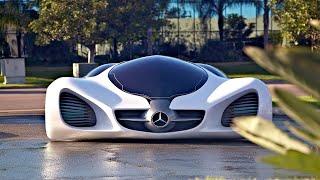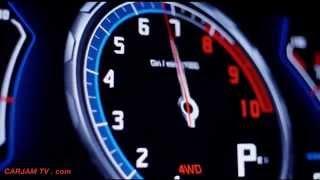The BMW M4 Coupé will again head the safety Car fleet in the MotoGP World Championship in 2015. BMW M Division’s high-performance coupé has been designed to ensure maximum driving dynamics and with its use on the racetracks of this world in mind. The six-cylinder inline engine with M TwinPower Turbo technology, a high-rev concept and distinct racing genes contributes significantly to the high-performance character of the overall concept. Already in its production version, the sporting heart delivers a top performance of 431 hp (317 kW) and provides a maximum torque of 550 Nm (combined fuel consumption of 8.8-8.3 l/100 km, combined CO2 emissions of 204-194 g/km) over a broadly usable range of revolution speeds.
The engineers at BMW M Division have equipped the high-performance power unit with an innovative water injection, thus considerably increasing the engine’s performance.
The water injection system employed by BMW M Division further optimises the performance and consumption of the charged six-cylinder, inline engine at full throttle. The engineers make use of the water’s physical effect during the vaporisation process to extract the energy required from the environmental medium. Water is injected into the intake module’s collector as a fine spray, thus significantly cooling the exhaust air during vaporisation. This lowers the discharge temperature in the combustion changer and thus reduces the tendency for knocking. The turbo engine can thus be operated with a higher charging pressure and an earlier ignition point.
The lower process temperatures also reduce the formation of hazardous substances, in particular nitrogen oxide. Water injection consequently dramatically improves the effectiveness of the engine. The technology increases performance and torque, whilst at the same time ensuring outstanding consumption and emission figures. As such, the improved performance can be achieved without increasing the heat applied to performance-related components, meaning the reliability of these parts is not affected.
The advantages of water injection can be used in different ways, depending on the engine and vehicle design. The engineers hereby have relatively free rein to decide to what extent they wish to optimise either the performance or the consumption of the power unit.
When a turbo engine whose turbo charger reaches its maximum speed at nominal output is fully charged, additional water injection makes it possible to increase performance and reduce consumption by about eight per cent. At the same time, losses in performance as a result of rising ambient temperatures (greater than 20 °C) are also compensated by increasing the amount of water being injected. And finally: instead of more performance, water injection can also be configured to reduce consumption, thus allowing more savings when fully loaded.
If water injection is taken into account when designing a high-performance engine, the turbocharger can be implemented with a suitably high degree of supercharging, whilst at the same time achieving a high compression ratio. The result is a substantial increase in performance and the reduction of consumption and emission figures when fully loaded.
If you love cars, you should subscribe now to YouCar's channel: http://urlz.fr/lEd
Go ahead, it's free!
All the Best.
-------------------------------------------------------
Website: http://www.youcarnews.com
Facebook: http://www.facebook.com/youcarpress
The engineers at BMW M Division have equipped the high-performance power unit with an innovative water injection, thus considerably increasing the engine’s performance.
The water injection system employed by BMW M Division further optimises the performance and consumption of the charged six-cylinder, inline engine at full throttle. The engineers make use of the water’s physical effect during the vaporisation process to extract the energy required from the environmental medium. Water is injected into the intake module’s collector as a fine spray, thus significantly cooling the exhaust air during vaporisation. This lowers the discharge temperature in the combustion changer and thus reduces the tendency for knocking. The turbo engine can thus be operated with a higher charging pressure and an earlier ignition point.
The lower process temperatures also reduce the formation of hazardous substances, in particular nitrogen oxide. Water injection consequently dramatically improves the effectiveness of the engine. The technology increases performance and torque, whilst at the same time ensuring outstanding consumption and emission figures. As such, the improved performance can be achieved without increasing the heat applied to performance-related components, meaning the reliability of these parts is not affected.
The advantages of water injection can be used in different ways, depending on the engine and vehicle design. The engineers hereby have relatively free rein to decide to what extent they wish to optimise either the performance or the consumption of the power unit.
When a turbo engine whose turbo charger reaches its maximum speed at nominal output is fully charged, additional water injection makes it possible to increase performance and reduce consumption by about eight per cent. At the same time, losses in performance as a result of rising ambient temperatures (greater than 20 °C) are also compensated by increasing the amount of water being injected. And finally: instead of more performance, water injection can also be configured to reduce consumption, thus allowing more savings when fully loaded.
If water injection is taken into account when designing a high-performance engine, the turbocharger can be implemented with a suitably high degree of supercharging, whilst at the same time achieving a high compression ratio. The result is a substantial increase in performance and the reduction of consumption and emission figures when fully loaded.
If you love cars, you should subscribe now to YouCar's channel: http://urlz.fr/lEd
Go ahead, it's free!
All the Best.
-------------------------------------------------------
Website: http://www.youcarnews.com
Facebook: http://www.facebook.com/youcarpress
- Category
- Autos & Vehicles













Comments